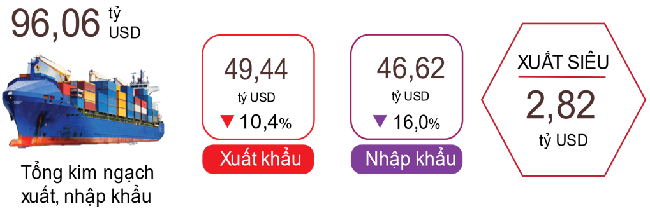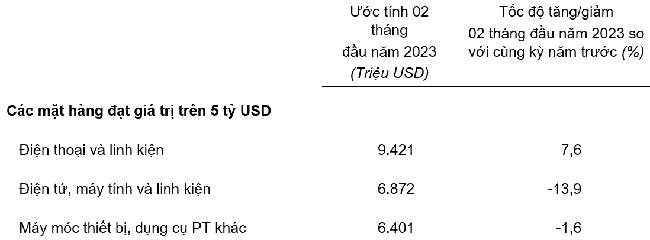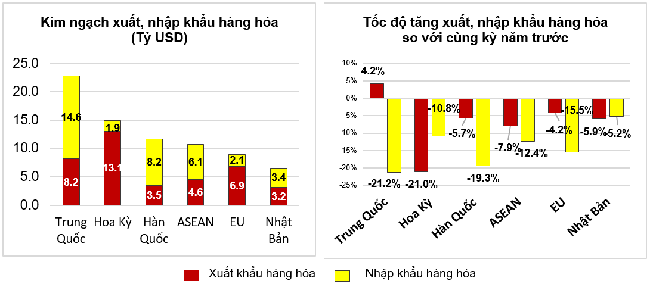[ad_1]
According to data released by the General Statistics Office on the morning of February 28, the total export and import turnover of goods reached US$49.46 billion in February 2023, up 6.1% month-on-month and up by 1.8% over the same period last year.
In general, the total export and import turnover of goods in the first two months of 2023 reached 96.06 billion US dollars, down 13.2% from the same period last year, of which exports fell 10.4 % decreased; imports fell by 16%. The goods trade balance had a trade surplus of $2.82 billion in the first two months of 2023.

In terms of exports in particular, they reached $25.88 billion in February 2023, up 9.8% month-on-month. The domestic economic sector reached USD 6.08 billion, an increase of 11.7%; The FDI sector (including crude oil) reached $19.8 billion, up 9.3%.
Compared with the same period last year, export sales of goods increased by 11% in March 2023, of which the domestic economic sector increased by 5.7%, FDI sector (including crude oil) by 5.7% and 12.7%.
In general, goods export revenue was estimated at US$49.44 billion in the first two months of 2023, down 10.4% from the same period last year. In this area, the domestic economic sector reached US$11.52 billion, down 21.1%, accounting for 23.3% of the total export turnover; The foreign investment sector (including crude oil) reached US$37.92 billion, down 6.6% and accounting for 76.7% share.
In the first two months of 2023, there are 08 items with export sales over USD 1 billion, accounting for 69.9% of the total export sales (there are 03 export products with over USD 5 billion, accounting for 45.9%).

In terms of the structure of export commodity groups in the first two months of 2023, fuels and mineral products were estimated at $652 million, up 1.3%; processed industrial products were valued at US$44.38 billion, accounting for 89.8%; agricultural and forestry products were valued at $3.4 billion, accounting for 6.9%; Seafood products are valued at $1.01 billion, up 2%.
From the opposite direction, imported goods turnover reached $23.58 billion in February 2023, up 2.3% month-on-month. The domestic economic sector gained USD 7.7 billion, up 2.5%; The FDI sector hit $15.88 billion, up 2.3%. Compared with the same period last year, import turnover in February 2023 fell by 6.7%, of which the domestic economic sector fell by 7.2%; The FDI sector fell by 6.4%.
In general, the import turnover of goods reached USD 46.62 billion in the first two months of 2023, down 16% from the same period last year, of which the domestic economic sector reached USD 15.21 billion, a decrease of 17.3%; The FDI sector reached US$31.41 billion, down 15.3%.
In the first two months of 2023, there were 13 imported items valued at over $1 billion, accounting for 69.1% of the total import sales (there were 2 imported items valued at over $5 billion, accounting for 39.3 %).

In terms of the structure of imported goods in the first two months of 2023, production materials were estimated at USD 43.64 billion, accounting for 93.6%, of which machinery, equipment, tools and spare parts accounted for 46.3%; Raw materials, fuels and materials accounted for 47.3%. Consumer Goods is valued at $2.98 billion, up 6.4%.
In terms of the export and import market for goods in the first two months of 2023, the United States is Vietnam’s largest export market with an estimated turnover of USD 13.1 billion. China is Vietnam’s largest import market with an estimated turnover of US$14.6 billion. In the first two months of 2023, the trade surplus with the EU was estimated at USD 4.8 billion, up 1.8% compared to the same period last year; China Trade Deficit At US$6.4 Billion, Down 39.8%; Korea’s trade deficit at $4.7 billion, down 27.2%; ASEAN trade deficit was US$1.5 billion, down 23.9%; Japan’s trade deficit is $237.2 million, up 4.5%.

So, with the above results, February 2023 had a trade surplus of $2.3 billion. In the first two months of 2023, the goods trade balance showed a trade surplus of $2.82 billion (in the same period last year, the trade deficit was $0.3 billion). In which the domestic economic sector has a trade deficit of USD 3.69 billion; The FDI sector (including crude oil) had a trade surplus of $6.51 billion.
Although export activity showed positive signs in February 2023, the 6% growth target for the full year 2023 still faces many challenges.
The first, The global economy continues to face many difficulties, especially in the major economies that are the leading import markets in the world and Vietnam, such as the US, EU, Japan… China. Although the zero covid policy has just ended, there are still many complicated factors and the situation of the covid-19 epidemic is still unpredictable.
Monday, Shocks in the supply chain lead to rising commodity prices. Accordingly, the cost of producing goods is high, which reduces the competitiveness of domestic goods.
Tuesday, In the world, the inflation situation is high, inventories are high, which affects consumer demand for imported goods, with the greatest impact being exerted on non-essential goods, which are export goods. Vietnam’s main products for developed countries’ markets, such as textiles, garments, shoes, etc.
Although Vietnam still faces many challenges, its export activities still have certain advantages. That means Vietnam is one of the few countries with great openness, up to 15 free trade agreements (FTAs) have been signed and are coming into force. When used effectively, this is the strength in boosting Vietnam’s exports.
In addition, attracting domestic investment and positive foreign investment will be the driving force to create new production capacity for export; At the same time, Vietnamese companies continue to encourage initiative and creativity, seek new markets and take advantage of free trade agreements.
[ad_2]
Source link

